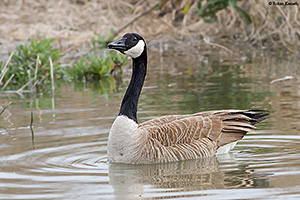 |
Canada Goose
Branta canadensis |
|
|
STANFORD LOCATIONS: Please let us know if you see Canada Geese on campus. To submit a sighting click on Stanford Locations. |
 |
Location |
Type |
Mating System |
Parental Care |
2ndary Diet |
Strategy |
|
|
|
|
I: 25-30 DAYS PRECOCIAL 2 |
|
|
|
|
(4-10) MONOG |
MF |
|
GROUND GLEAN |
| BREEDING: | Freshwater and brackish marshes, meadows, small islands. 1 brood. |
| DISPLAYS: | Courting male holds head 1"off ground, bill open, tongue raised, hissing loudly, quills shaking, approaches female, and passes neck around hers. |
| NEST: | Usu near water, of dry grass, forbs, moss, sticks, aquatic veg, etc., feathers; down added as incubation begins. Occ of conifer needles, bark chips, lined with down. Occ use abandoned nest, esp if ground snow-covered; occ human-made structure. |
| EGGS: | White, nest-stained. 2.9-3.6" (74-90 mm). |
| DIET: | Shoots, roots, and seeds of grass and sedges, bulbs, grain, berries; also insects, crustaceans, mollusks. Mostly grain and foliage in winter. |
| CONSERVATION: | Winters s to n Mexico. Aleutian Canada Goose was removed from the list of Endangered and Threatened Wildlife in 2001. Most grain consumption is postharvest. Flocks often found in urban parks with lakes or rivers; semi-domesticated. |
| NOTES: | Long-term pair bond. Strong fidelity to nesting territory. Breeding usu in third year, occ in second year. Male usu leads young on water; if disturbed, young dive. Male performs distraction display. Sentinels constantly guard foraging flocks. |
| ESSAYS: | How Long Can Birds Live? Visual Displays; Flying in Vee Formation; Metallic Poisons; Birds and the Law; Site Tenacity. |
| REFERENCES: | Bellrose, 1976; Craven, 1984; Godfrey, 1986; Prevett et al., 1985. |
| Help | Abbreviations | Species-Alphabetical | Species-Taxonomic | Essays-Alphabetical | |
| Except for Stanford Locations, the material in this species treatment is taken, with permission, from The Birder's Handbook (Paul Ehrlich, David Dobkin, & Darryl Wheye, Simon & Schuster, NY. 1988). | |||||